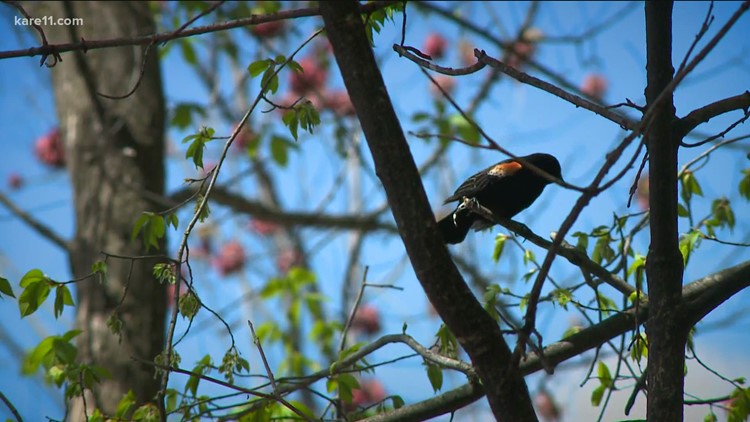INDIANAPOLIS —
Amid the onslaught of cars rushing round on Monument Circle, sounds of twittering birds beckon in another morning. Birds that you normally find on your bird feeder, orioles, hummingbirds, the occasional warbler, or a few woodpeckers could make an appearance.
Many of these birds are new, or freshly returned, to town. During spring migration, from the end of April to the first of May, more than 420 species will pass through Indianapolis during spring migration.
Not all of them make it through the night.
"They get drawn in maybe kind of like a moth to light somewhat. They get drawn into the urban jungle so to speak, where they encounter windows or feral cats or just unfamiliar surroundings," Austin Broadwater, chair of the Lights Out Indy organization, told 13News.
Birds using stars to migrate get sucked into the city and become disoriented. Sometimes birds will fly around until they die from exhaustion, but one of the biggest cause of bird deaths is tall buildings. The birds fly into them and meet a grisly end.
Every migration season, Lights Out Indy calls attention to the hazards bright city lights pose for species migrating from the south.
Before dawn a few times a month and more during migration, Lights Out volunteers descend downtown looking for injured or deceased birds that collided with tall buildings during the night.
"If you come downtown and thinking, 'I don't see any dead birds' well they most likely have been cleaned up or scavenged. Or they might have struck and flown off," Broadwater said.
Injured birds are sent to a local rehab center, while recovered specimen are kept at the Eagle Creek Ornithology Center for further study.
A majority of birds are found at the Convention Center, Broadwater told 13News.
"Probably about 20% of the birds we find are injured. Most of them are, unfortunately, deceased," Broadwater said.
Studies say anywhere from 600 million to 1 billion birds die in building collisions during spring migration throughout the U.S. every year, but dimming lights can offer some solutions.
Cities like Dallas, Chicago and New York have already taken measures to dim building lights at night in the wake of spring migration.
Several Indy businesses have implemented measures to protect birds. Salesforce launched a campaign to dim their lights last fall, and Newfields installed a specialized glass that will prevent birds from flying into it.
But, unlike some other cities, there is no concentrated legislation centered around dimming lights during spring and fall migration. The organization hopes to introduce legislation in the future to prevent more birds from dying in the greater Indianapolis area next session.
"Because it's not just the main city. Lights in suburban areas, turning those off help as well," Broadwater said.
In the meantime, conservationists say getting local businesses on board is crucial because one 2014 study shows tall buildings are not always the biggest culprit of bird collision deaths.
Research published in "The Condor: Ornithological Applications" found 56% of the mortality events happened at low-rises buildings — four to 11 stories tall — while 44% happened at residences.
Here are some ways you can help:
- If you work at one of those large structures, try to speak with management to get them to turn their lights off during the migratory seasons.
- Support bird-friendly legislation.
- Turn off decorative outdoor lighting.
- Extinguish pot lights and floodlights.
- Turn off interior lighting on higher stories.
- Install motion sensors and controls whenever possible.
- Install bird-safe glass products that reduce transparency and reflectivity.
- Provide each window with exterior screens, netting or shutters.
- Apply films, bird tape or decals using the appropriate spacing.
- Print ceramic patterns onto glass, which also adds to aesthetics.
- Turn off lights when not in use.
- Be cognizant of where vegetation is placed around buildings.



